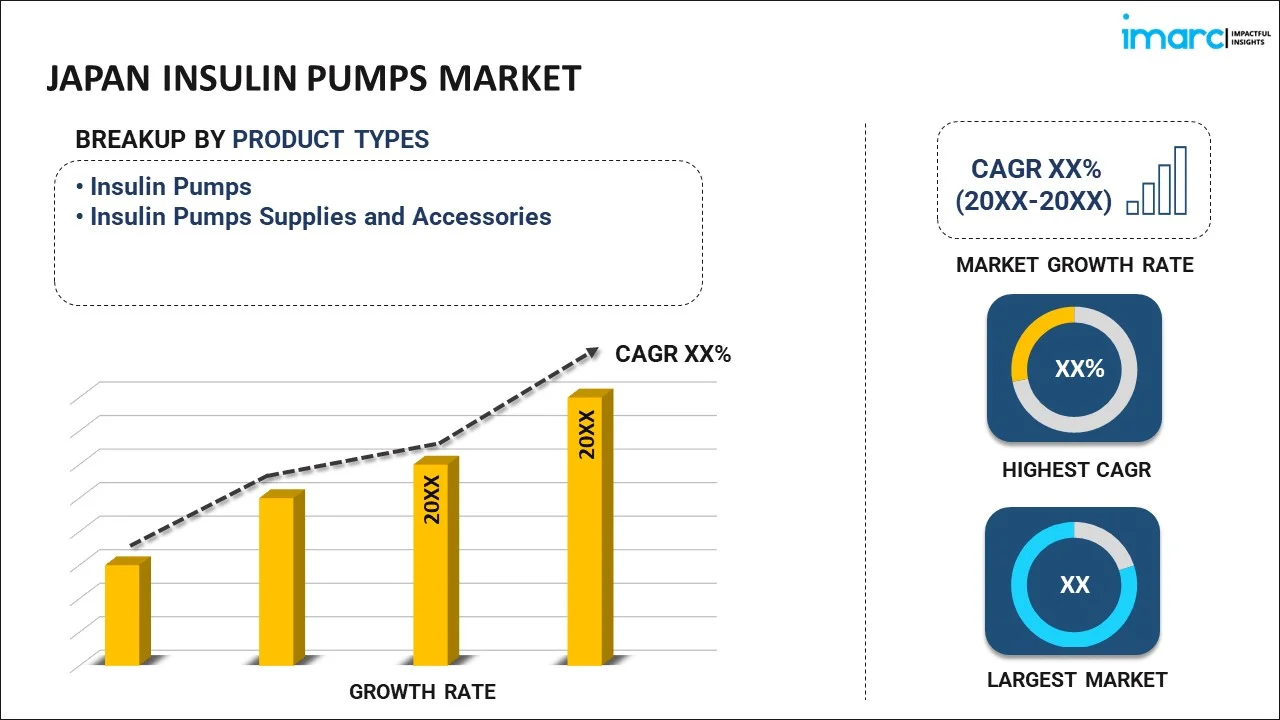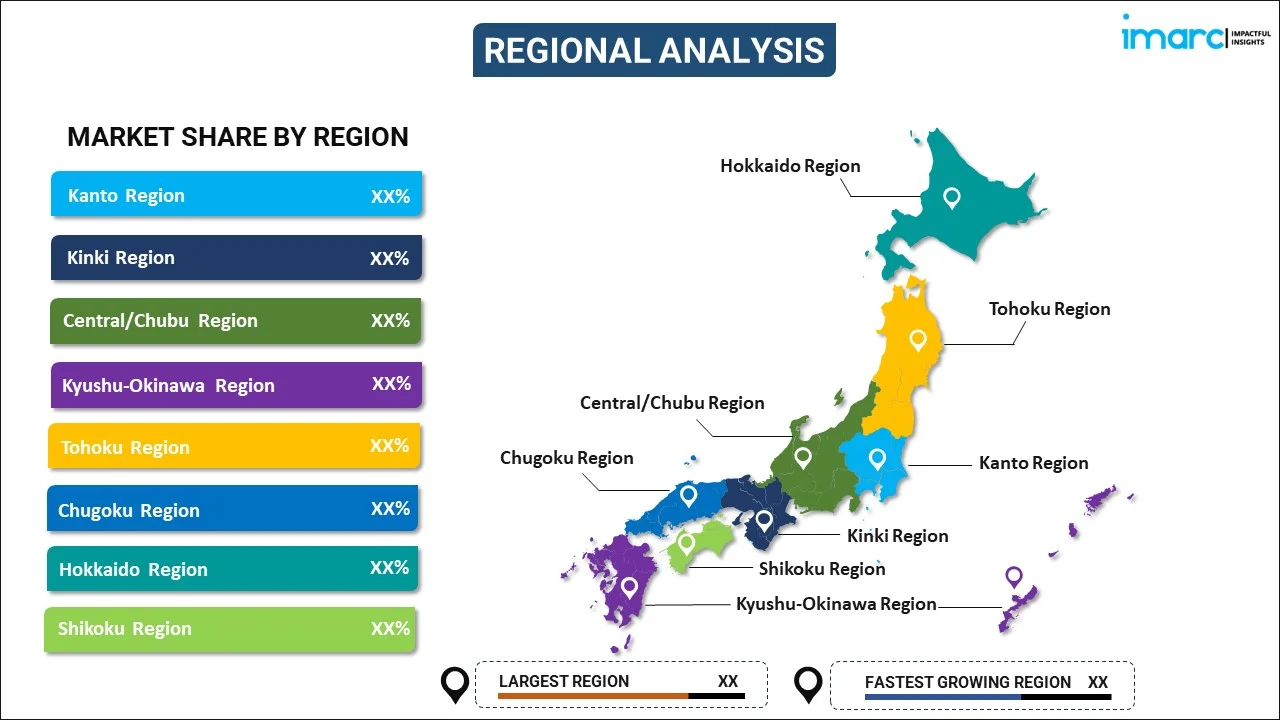
Japan Insulin Pumps Market Report by Product Type (Insulin Pumps, Insulin Pumps Supplies and Accessories), Distribution Channel (Hospital Pharmacy, Retail Pharmacy, Online Sales, Diabetes Clinics/Centers, and Others), and Region 2025-2033
Market Overview:
The Japan insulin pumps market size reached USD 331.2 Million in 2024. Looking forward, IMARC Group expects the market to reach USD 545.5 Million by 2033, exhibiting a growth rate (CAGR) of 5.7% during 2025-2033. The increasing prevalence of diabetes, the rising preference for insulin pumps over traditional insulin injections, rapid technological advancements, increasing geriatric population, and enhanced focus on research and development (R&D) activities represent some of the key factors driving the market.
|
Report Attribute
|
Key Statistics
|
|---|---|
|
Base Year
|
2024
|
|
Forecast Years
|
2025-2033
|
|
Historical Years
|
2019-2024
|
|
Market Size in 2024
|
USD 331.2 Million |
|
Market Forecast in 2033
|
USD 545.5 Million |
| Market Growth Rate 2025-2033 | 5.7% |
Insulin pumps are small electronic devices that deliver insulin to individuals with diabetes. They are typically worn externally, either on a belt or in a pocket, and are connected to the body through a thin tube called an infusion set. The pump delivers insulin continuously, mimicking the function of a healthy pancreas. As compared to traditional insulin injections, insulin pumps offer a more flexible and precise way of administering insulin. They can deliver both basal insulin, which is a small amount of insulin continuously released to control blood sugar levels between meals and during sleep, as well as bolus insulin, which is a larger dose of insulin taken before meals to cover the rise in blood sugar after eating.
Japan Insulin Pumps Market Trends:
One of the major factors driving the Japan insulin pumps market is the increasing prevalence of diabetes. Insulin pumps offer greater convenience, flexibility, and precision in insulin delivery and help improve blood sugar control, reduce hypoglycemia (low blood sugar) episodes, and enhance the overall quality of life for many individuals with diabetes. In line with this, the rising preference for insulin pumps over traditional insulin injections due to the convenience and lifestyle benefits they offer is acting as another growth-inducing factor. Moreover, the implementation of various initiatives by the Japanese government to provide coverage for various medical treatments, including diabetes management, is creating a positive outlook for the market. Apart from this, continuous technological advancements in insulin pumps, such as the development of smart pumps with integrated continuous glucose monitoring (CGM) systems that offer improved accuracy, ease of use, and better glycemic control for patients is providing a considerable boost to the market growth. Furthermore, the increasing awareness about the benefits of insulin pumps and proper diabetes management among the masses is propelling the market growth. Additionally, the growing trend toward minimally invasive (MI) medical technologies aligns with the appeal of insulin pumps, which involve needle insertion only during the infusion set change is contributing to the market growth. Other factors, including significant growth in the healthcare industry, rising expenditure capacities of consumers, rapid technological advancements, increasing geriatric population, enhanced focus on research and development (R&D) activities, and growing demand for effective and convenient diabetes management solutions, are presenting remunerative growth opportunities for the market.
Japan Insulin Pumps Market Segmentation:
IMARC Group provides an analysis of the key trends in each segment of the Japan insulin pumps market report, along with forecasts at the country level for 2025-2033. Our report has categorized the market based on product type and distribution channel.
Product Type Insights:

- Insulin Pumps
- Tethered Pumps
- Disposable/Patch Insulin Pumps
- Insulin Pumps Supplies and Accessories
- Infusion Set Insertion Devices
- Insulin Reservoirs/Cartridges
The report has provided a detailed breakup and analysis of the market based on the product type. This includes insulin pumps (tethered pumps and disposable/patch insulin pumps) and insulin pumps supplies and accessories (infusion set insertion devices and insulin reservoirs/cartridges).
Distribution Channel Insights:
- Hospital Pharmacy
- Retail Pharmacy
- Online Sales
- Diabetes Clinics/Centers
- Others
A detailed breakup and analysis of the market based on the distribution channel has also been provided in the report. This includes hospital pharmacy, retail pharmacy, online sales, diabetes clinics/centers, and others.
Regional Insights:

- Kanto Region
- Kinki Region
- Central/Chubu Region
- Kyushu-Okinawa Region
- Tohoku Region
- Chugoku Region
- Hokkaido Region
- Shikoku Region
The report has also provided a comprehensive analysis of all the major regional markets, which include Kanto Region, Kinki Region, Central/Chubu Region, Kyushu-Okinawa Region, Tohoku Region, Chugoku Region, Hokkaido Region, and Shikoku Region.
Competitive Landscape:
The report has also provided a comprehensive analysis of the competitive landscape in the market. Competitive analysis such as market structure, key player positioning, top winning strategies, competitive dashboard, and company evaluation quadrant has been covered in the report. Also, detailed profiles of all major companies have been provided.
Japan Insulin Pumps Market Report Coverage:
| Report Features | Details |
|---|---|
| Base Year of the Analysis | 2024 |
| Historical Period | 2019-2024 |
| Forecast Period | 2025-2033 |
| Units | Million USD |
| Scope of the Report | Exploration of Historical and Forecast Trends, Industry Catalysts and Challenges, Segment-Wise Historical and Predictive Market Assessment:
|
| Product Types Covered |
|
| Distribution Channels Covered | Hospital Pharmacy, Retail Pharmacy, Online Sales, Diabetes Clinics/Centers, Others |
| Regions Covered | Kanto Region, Kinki Region, Central/Chubu Region, Kyushu-Okinawa Region, Tohoku Region, Chugoku Region, Hokkaido Region, Shikoku Region |
| Customization Scope | 10% Free Customization |
| Post-Sale Analyst Support | 10-12 Weeks |
| Delivery Format | PDF and Excel through Email (We can also provide the editable version of the report in PPT/Word format on special request) |
Key Questions Answered in This Report:
- How has the Japan insulin pumps market performed so far and how will it perform in the coming years?
- What has been the impact of COVID-19 on the Japan insulin pumps market?
- What is the breakup of the Japan insulin pumps market on the basis of product type?
- What is the breakup of the Japan insulin pumps market on the basis of distribution channel?
- What are the various stages in the value chain of the Japan insulin pumps market?
- What are the key driving factors and challenges in the Japan insulin pumps market?
- What is the structure of the Japan insulin pumps market and who are the key players?
- What is the degree of competition in the Japan insulin pumps market?
Key Benefits for Stakeholders:
- IMARC’s report offers a comprehensive quantitative analysis of various market segments, historical and current market trends, market forecasts, and dynamics of the Japan insulin pumps market from 2019-2033.
- The research study provides the latest information on the market drivers, challenges, and opportunities in the Japan insulin pumps market.
- Porter's five forces analysis assist stakeholders in assessing the impact of new entrants, competitive rivalry, supplier power, buyer power, and the threat of substitution. It helps stakeholders to analyze the level of competition within the Japan insulin pumps industry and its attractiveness.
- Competitive landscape allows stakeholders to understand their competitive environment and provides an insight into the current positions of key players in the market.
Need more help?
- Speak to our experienced analysts for insights on the current market scenarios.
- Include additional segments and countries to customize the report as per your requirement.
- Gain an unparalleled competitive advantage in your domain by understanding how to utilize the report and positively impacting your operations and revenue.
- For further assistance, please connect with our analysts.

 Inquire Before Buying
Inquire Before Buying
 Speak to an Analyst
Speak to an Analyst
 Request Brochure
Request Brochure
 Request Customization
Request Customization



.webp)




.webp)












